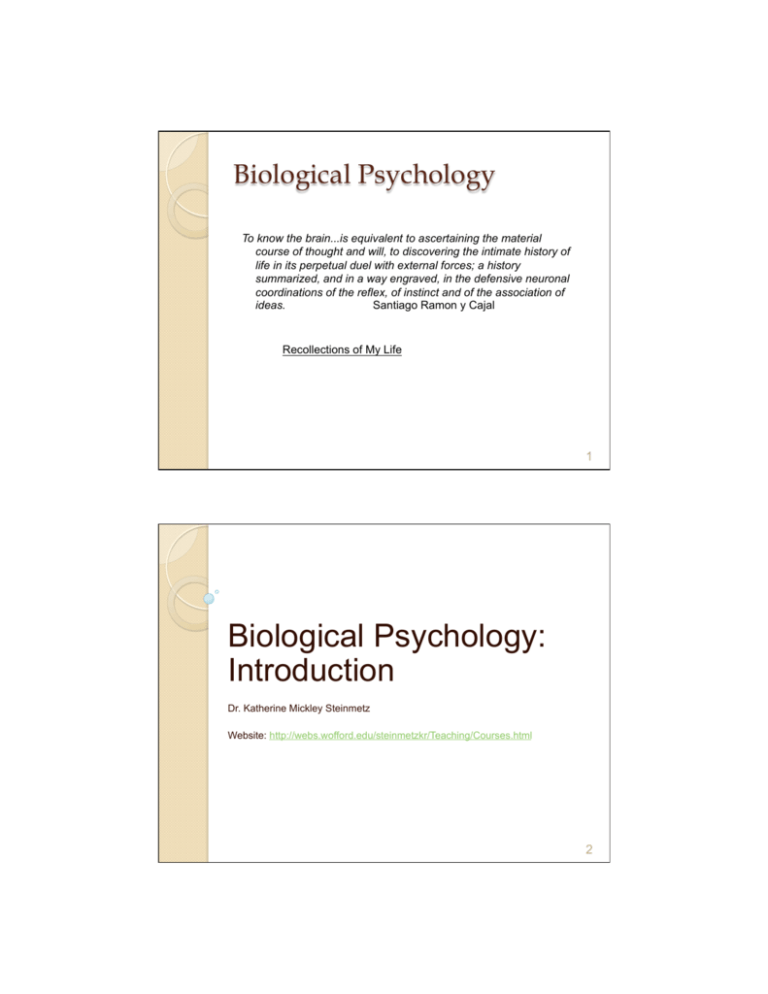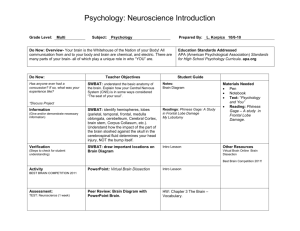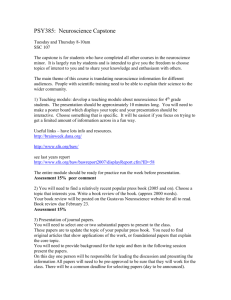Introduction-Biological Psychology
advertisement

Biological Psychology To know the brain...is equivalent to ascertaining the material course of thought and will, to discovering the intimate history of life in its perpetual duel with external forces; a history summarized, and in a way engraved, in the defensive neuronal coordinations of the reflex, of instinct and of the association of ideas. Santiago Ramon y Cajal Recollections of My Life 1 Biological Psychology: Introduction Dr. Katherine Mickley Steinmetz Website: http://webs.wofford.edu/steinmetzkr/Teaching/Courses.html 2 Course Structure Exam 1 – Anatomy, Structure, & Function of the nervous system Exam 2 – Interactions with the Environment: Sensory Systems & Homeostatic Systems Exam 3 – Cognitive Neuroscience: Emotion, Learning & Memory, Language Final Exam – Neuroscience Disorders: Autism, ADD, Depression, OCD, Anxiety, Schizophrenia, and Alzheimer’s Disease 3 Introduction to Biological Psychology Neuroscience Research Neuroscience History ◦ Monism vs. Dualism ◦ What can modern neuroscience tell us? Introduction to Biological Psychology Neuroscience Research Neuroscience History ◦ Monism vs. Dualism ◦ What can modern neuroscience tell us? The Grand Challenges for Neuroscience in the 21st Century Institute of Medicine - 2008 How does the brain work and produce mental activity? ◦ How does physical activity in the brain lead to thought, emotion, and other behaviors? Nature and nurture: How does the interplay of biology and experience shape our brains and make us who we are today? How do we keep our brains healthy? ◦ How do we protect, restore, or enhance the functioning of our brains as we age? 6 Neuroscience Research Human & animal studies ◦ What are the benefits of each? 7 The nervous system is remarkably similar between humans and other animals. 8 Strict guidelines regulate the use of animals in research At WOFFORD: Animal Care and Use Committee: Veterinarian, Non-Scientist, Non-Affiliated with Wofford, Scientists both conducting and not conducting research Inspects all areas where animals are housed or tested Reviews and approves every research protocol using animals on campus 9 Introduction to Biological Psychology Neuroscience Research Neuroscience History ◦ Monism vs. Dualism ◦ What can modern neuroscience tell us? Neuroscience History Hippocrates: The brain is the source of intellect Galvani & du Bois-Reymond: Nervous system communicates by electricity Ramon y Cajal: nervous system is composed of separate cells 11 Question? Is your person (personality) in your brain? Are you your brain? ◦ Mind - body issue. ◦ What can neuroscience tell us about this question? 12 Dualism Rene Descartes’ experiences Dualism: ◦ Humans = physical bodies and nonphysical minds, or souls ◦ Mind is not physical, so it can’t be studied Dualism Mind and brain are 2 distinct phenomena Mind can control physical objects (through pineal and brain) Dualism Free will: ◦ We can choose to do what we wish ◦ Mind is not constrained by body ◦ Mind tells brain what to do 15 Monism Hippocrates: ◦ believed that mind was a function of the brain’s physiological processes Mind and body are both biological phenomena Monism Mental states are just physiological states of the brain Mind is a phenomenon produced by the workings of the body – emerging from brain If we could fully understand the workings of the body, we could understand mind/soul as well as how we think, perceive, remember and act. 17 Monism Determinism: Behavior is caused by previous physical events and environmental influences. Free will: is a myth bolstered by the complexity of human brain and our own self-awareness that makes us feel like our minds control our bodies. 18 Free Will Video 19 http://www.youtube.com/watch?v=fI1624SwYnI&feature=related Mind-Body Question Who’s right? Monists? Dualists? Data from this course can speak to this question Examples: ◦ Phineas Gage ◦ Split brain patients ◦ Prefrontal Lobotomy 20 Phineas Gage Dynamite worker using a steel rod to ram a charge into a hole Charge exploded and sent rod through his cheek/orbitofrontal cortex 21 Phineas Gage What’s it like to have a 1.25-inch diameter tamping iron blasted through your head? The rod that went through Gage’s Brain 23 Phineas Gage Computer reconstruction Phineas Gage Computer Reconstruction Phineas Gage Personality changes ◦ Before: serious, industrious, energetic ◦ After: Childish, irresponsible, thoughtless, unable to carry out plans, capricious 26 Generalizations from similar cases Damage to orbitofrontal cortex: ◦ Reduces inhibitions ◦ Persons become indifferent ◦ Pain no longer bothered them (indifference) 27 Split Brain Individuals Corpus Callosum cut Right and left hemisphere not communicating Very different personalities in each hemisphere Where is the “person”? 28 Split Brain http://www.youtube.com/watch?v=PFJPtVRlI64 29 Prefrontal Lobodomy Animal studies: Jacobsen, Wolfe and Jackson (1935). Becky the chimp Frontal lobe removal reduced frustration reaction and violent behaviors Egas Moniz: Nobel Prize (1949) Walter Freeman: http://www.youtube.com/watch?v=_0aNILW6ILk Could one reduce anxiety and frustration surgically? 30 Prefrontal Lobotomy Transorbital leucotome Patients could have lobotomy in Dr’s Office Prefrontal Lobotomy Tens of thousands done in 50s - 70s Trans-orbital leucotome Results: ◦ Reduced violent behaviors ◦ Irresponsible and childlike ◦ Unemployable ◦ Different personality 32 Question? Is your person (personality) in your brain? Are you your brain? ◦ Mind - body issue. ◦ What can neuroscience tell us about this question? 33 Please share your thoughts … 1. 2. 3. 4. Name (Phonetic Spelling) What do you hope to get out of this class? Do you have any neuroscience experience (personal or academic)? If so, what? What do you think will be the most challenging about this class? What are you most excited about? 34 For Next Time… Read Chapter 2: Neuroanatomy Lab Tomorrow: Week 1 Structures ◦ Lab Practical ◦ Review the names and Human Plates ◦ Spelling Counts! 35





